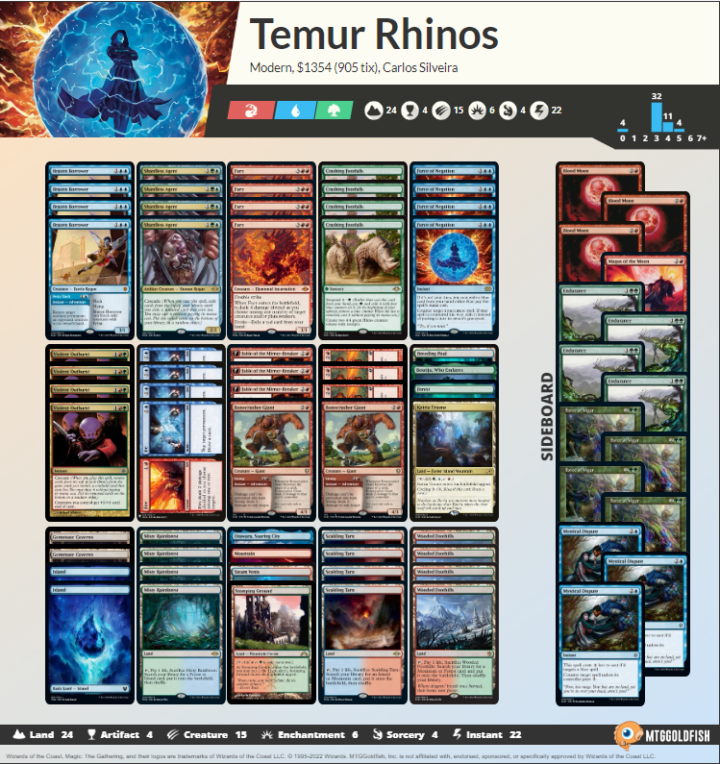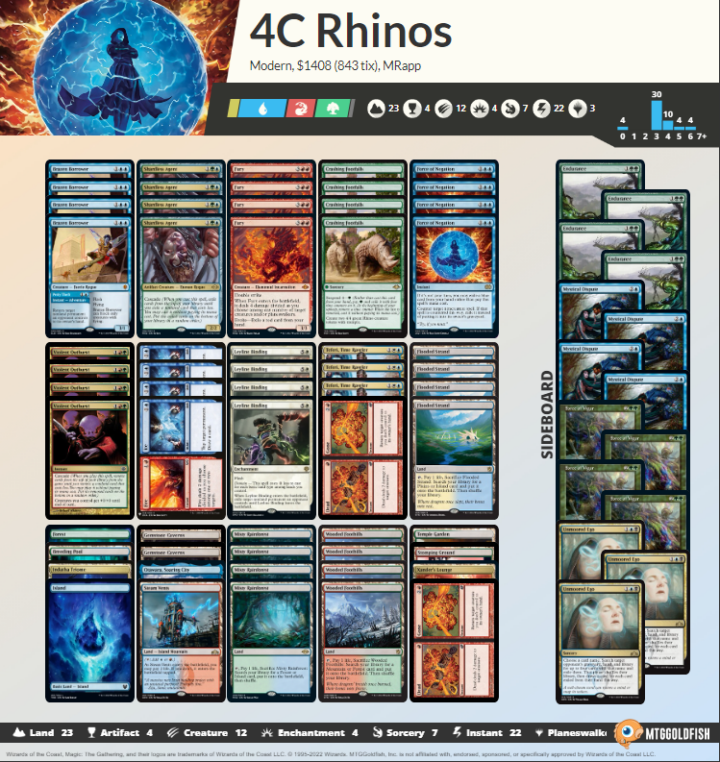At the beginning of what I call the New Modern era (Modern Horizons and forward), Rhinos decks centered around cascading into Crashing Footfalls burst onto the scene and remained a top tier deck for some time. But at some point, Modern adjusted and Rhinos fell out of favor — replaced by Living End and Glimpse combo.
However, Leyline Binding seems to be breathing new life into our horned friends. Traditionally, Rhinos has relied on Petty Theft to try and answer troublesome permanents, but that isn’t exactly the most concrete solution to many problems.
Due to the nature of the Cascade mechanic, many efficient answers to cards like Teferi, Time Raveler, Chalice of the Void and Ensnaring Bridge can’t be played in Rhinos without disrupting the game plan. Leyline Binding’s mana value of six makes it different, though, and Rhinos now has access to a cheap, catchall answer.
This doesn’t mean the classic Temur version is without merit, though. It is the strategy distilled into its simplest form, and what it lacks in answers it makes up in efficiency. Let’s take a look at all the versions and see how they compare.
Temur
Temur Rhinos is the classic version of the strategy — sleek and streamlined. Temur is very good at playing the same game every game. The curve of tap land (or Dead) on turn one; Stomp, Fire//Ice or Petty Theft on turn two; into Crashing Footfalls on turn three is rock solid and retains quite the pedigree.
While Temur doesn’t have access to the new hotness, Leyline Binding, it does still have access to Blood Moon, which I like quite a bit right now. Being able to slow down Creativity and Amulet while still getting Rhinos into play following a Blood Moon is tough for these greedy mana bases to beat.
Rhinos leverages free spells such as Force of Negation, Fury, Force of Vigor and Endurance better than almost any deck in Modern. The cost of these cards is generally that they require an extra card to cast for free, which means, over the course of a game that continues for a while, you’ll be down a card.
Still, that matters much less when you have 10 power attacking on turn four. In a metagame with a lot of Creativity, Titan, Tron, and to some degree Living End and Azorius Hammer, Blood Moon is an excellent choice. That means Temur Rhinos is one of the best decks to leverage it.
Four-Color Rhinos
The next evolution of Temur rhinos is Four-Color Rhinos, which splashes white for Leyline Binding and Teferi, Time Raveler. I’ve seen versions of this deck with Scion of Draco instead of Brazen Borrower to add an extra aggressive threat, or early blocker, and while it does have its good matchups, I prefer the flexibility and utility of Brazen Borrower in that spot.
The strength of Four-Color Rhinos is that Leyline Binding and Teferi are just upgrades over Bonecrusher Giant and Fable of the Mirror-Breaker. While Bonecrusher and Fable offer a bit of alternative pressure, I think both are inefficient. With Teferi and Binding, Four-Color Rhinos is good enough at beating opposing hate that the deck can deploy a more focused game plan.
Teferi is particularly powerful, as it beats both permanent and stack-based hate, making sure our Rhinos successfully resolve while also clearing the way of any pesky blockers. The black splash for Domain also comes in handy by letting Four-Color Rhinos also play Unmoored Ego out of the sideboard to really hammer combo decks like Creativity and Living End.
The 60 card, Four-Color Rhinos is the version I personally like the most. It maintains the streamlined gameplan of Temur while getting access to the powerful white cards that shore up a lot of potential problems.
YoRhinos
Four-Color Yorion meets Four-Color Rhinos in YoRhinos. This version of Rhinos adds twenty cards to Four-Color Rhinos to support Yorion. Solitude, The Wandering Emperor, Ardent Plea and Omnath, Locus of Rage are the new additions to the team.
YoRhinos gives up on some of the streamlined plans that Temur and Four-Color Rhinos have in favor of additional, raw power. This pushes YoRhinos into a slower, more midrange centric build instead of a flash, tempo game.
Going up to 80 cards does come at a cost. You are going to see Force of Negation and your sideboard cards less often, which, in certain metagames, can be very punishing. The upside is if you’re playing in a metagame that is slower and fairer, Omnath and Solitude are solid options to fill the extra 20 cards to get Yorion.
End Step
Personally, I feel Rhinos is less of a good stuff deck and more of a deck that is good at executing one plan well. That means I’m going to favor Four-Color Rhinos instead of YoRhinos, which is built as much more of a good stuff deck.
Perhaps it is my preference for tempo strategies that pushes me in that direction, as well. Regardless, all three Rhinos variants have enough results and target different parts of the metagame to be valid options. Selecting the right version for your expected metagame will be important to your success with Rhinos.
As always you can find me on Twitter at @RappaciousOne for questions, comments or feedback. Until next week, happy cascading!

Michael Rapp is a Modern specialist who favors Thoughtseize decks. Magic sates his desire for competition and constant improvement.




